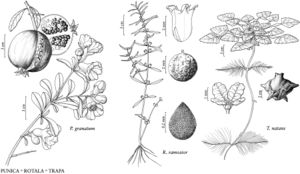Rotala
Mant. Pl. 2: 143, 175. 1771.
| Taxon | Illustrator ⠉ | |
|---|---|---|
 | Punica granatum Rotala ramosior Trapa natans |
Herbs, annual or perennial, terrestrial, amphibious, or aquatic, often turning pink or red, 0.4–4 dm, glabrous throughout. Stems erect, decumbent, or creeping [floating], unbranched or branched, often rooting at nodes. Leaves usually opposite, rarely whorled [subalternate], dimorphic or uniform; sessile or subsessile; blade obovate, orbiculate, oblongelliptic, oblanceolate, subspatulate, or linear [lanceolate, spatulate], base attenuate, obtuse, or rounded, margins membranous or cartilaginous. Inflorescences indeterminate, terminal or axillary racemes, axillary spikes, or solitary flowers (on main-stem). Flowers sessile or subsessile, actinomorphic, monostylous [distylous]; floral-tube perigynous, campanulate; epicalyx segments shorter to longer than sepals or absent; sepals [3 or] 4 [–6], to 1/2 floral-tube length; petals caducous or persistent, 0 or 4 [–6], rose, pink, or white [purple]; nectariferous tissue variably present at base of inner wall of floral-tube; stamens (1–) 4 [–6], in 1 whorl; ovary 2–4-locular; placenta globose, ultimately nearly free-central; style slender or stout; stigma capitate or thick-capitate. Fruits capsules, walls thin and dry, finely, transversely striate (10×), 2–4-valved, dehiscence septicidal. Seeds 30–100+, obovoid-semiovoid, convex-concave, 0.3–0.5 mm; cotyledons ± complanate. x = 8.
Distribution
North America, Mexico, West Indies, Central America, South America, Europe, s Asia, Africa
Discussion
Species ca. 50 (3 in the flora).
The native Rotala ramosior and introduced R. indica and R. rotundifolia are weeds in North American rice fields, irrigation ditches and canals, and other disturbed wet areas. Rotala ramosior is increasingly found elsewhere in the world in rice-growing regions. The genus often grows with one or more species of the superficially similar Ammannia (S. A. Graham et al. 2011). Some species of Rotala are part of the international aquatic plant trade.
Selected References
None.
Lower Taxa
Key
| 1 | Inflorescences terminal racemes, simple or compound; leaves dimorphic, aerial blades obovate to orbiculate, submerged blades linear to orbiculate; style stout; stigmas thick-capitate. | Rotala rotundifolia |
| 1 | Inflorescences terminal or axillary racemes, axillary spikes, or solitary flowers; leaves monomorphic, blades oblong-elliptic, oblanceolate, obovate to oblong, or subspatulate; style slender; stigmas capitate, not excessively thickened. | > 2 |
| 2 | Margins of leaves white-cartilaginous, blades obovate to oblong or subspatulate; flowers frequently in short axillary spikes or terminal or axillary racemes, sometimes solitary in axils of main stems; epicalyx segments absent. | Rotala indica |
| 2 | Margins of leaves membranous, blades oblong-elliptic to oblanceolate; flowers solitary in axils of main stems; epicalyx segments present. | Rotala ramosior |